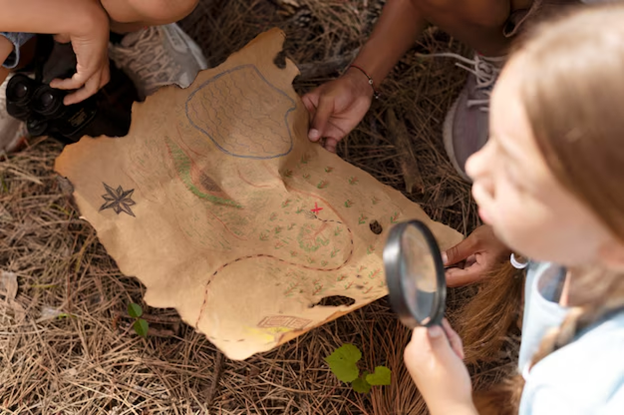8 Scavenger Hunt Ideas for Family Gatherings
TL; DR
Spice up family gatherings with 8 creative scavenger hunt ideas that get everyone off their phones and bonding! From nostalgic “Memory Lane” hunts (dig up family stories) to glow-in-the-dark nighttime quests, these games work for toddlers, teens, and grandparents. Mix riddles, photo clues, and themed challenges (pirate maps, holiday treasures) to keep it fresh.
Pro tips: test clues beforehand, use silly prizes, and embrace chaos—lost clues or hiding uncles become legendary stories. Perfect for indoors, outdoors, or rainy days, these hunts turn ordinary reunions into unforgettable adventures.
8 Scavenger Hunt Ideas for Family Gatherings

Family gatherings are those rare moments when everyone; from toddlers to grandparents—is under one roof, sharing laughter, stories, and food. But what happens after the dishes are cleared and people start checking their phones? That’s where a good old scavenger hunt becomes the perfect game-changer!
It’s an activity that gets everyone moving, thinking, and bonding. Whether you’re hosting indoors, outdoors, or a mix of both, here are some creative scavenger hunt ideas that will bring excitement to your next family get-together.
1. Photo Clue Hunt
A picture says a thousand words, and this scavenger hunt takes full advantage of it. Instead of written clues, leave photos to guide players to their next stop. For instance, take a close-up photo of the corner of a family heirloom or even the pattern on the carpet. Participants will need to recognize the object or location in the photo to proceed. This can be adapted for younger kids by using broader shots of the locations rather than zoomed-in puzzles.
Pro Tip: Encourage participants to take selfies with each clue as they find them. You’ll end up with a collection of candid and funny photos to look back on later!
2. Nature-Themed Hunt
If your family gathering is at a park, garden, or backyard, a nature scavenger hunt is a beautiful way to explore the outdoors while having fun. Create a list of items to find, such as a red leaf, a smooth rock, a bird feather, or even a unique-shaped cloud. Give everyone a small basket or bag to collect their finds (except for clouds, of course!).
You can make it engaging for all ages by including tasks like “Snap a photo of a squirrel” or “Count all the dandelions in the yard.”
3. Memory Lane Hunt
For a sentimental twist, why not create a scavenger hunt based on family history? Hide clues that point to significant moments or family members. For example, one clue might lead players to a photo on the wall of an old family vacation, while another could direct them to Aunt Patty’s famous cookie jar. You can sprinkle in fun trivia questions like, “Which cousin broke Grandma’s vase in 2005?” (Hopefully, no grudges remain!)
This hunt not only gets everyone involved but also keeps family stories alive for the younger generation.
4. Indoor Puzzle Hunt
Rain ruining your outdoor plans? No problem! Bring the fun inside with a puzzle scavenger hunt. Write clues that lead participants to puzzle pieces hidden around the house. Once all the pieces are found, the team works together to complete their puzzle. You can use jigsaw puzzles or even create a custom one with a family photo or message.
This is a great choice for large spaces and younger children, as it combines the thrill of hunting with the satisfaction of a final reveal.
5. Holiday-Themed Hunt
If your gathering is centered around a holiday, why not tailor the scavenger hunt to match?
- Christmas: Hide candy canes or small ornaments around the house for kids to collect.
- Easter: Beyond traditional egg hunts, give cryptic clues to keep older kids and adults guessing.
- Halloween: Scatter tiny pumpkins or spooky items like toy spiders for participants to discover.
The possibilities are endless when you tie the hunt to the spirit of the occasion.
6. Treasure Hunt with Map
Transform your scavenger hunt into an exciting pirate-style treasure hunt! Create a map (you don’t need to be an artist; stick figures get the job done) with marked locations for hidden “treasures.” Use small trinkets, candies, or even hand-written messages as rewards along the way.
This type of game can easily involve members of all ages. Have younger kids do the collecting while older participants translate the map.
7. Around-the-World Hunt
This is a scavenger hunt with a travel twist. Label different “stations” (could be rooms in the house or spots in the yard) as countries or cities. Participants must complete a small challenge at each location before moving on. For instance, at “Italy,” they might solve a pasta puzzle, while at “Japan,” they could master a simple origami fold. It’s creative, educational, and so much fun!
8. Mystery Scavenger Hunt
Channel your inner detective with a mystery-themed scavenger hunt. Instead of a list of items, give participants a case to solve. Clues might be riddles, logic puzzles, or hidden items that piece together the bigger story.
For example, “Who took Cousin Dan’s last slice of cake?” Or something light and silly to add to the laughs. This is especially great for older kids or adults who enjoy a bit of mental challenge.
5 Essential Tips for a Flawless Scavenger Hunt

1. Pick a Theme and Plan Like a Pro
- Theme it up: Choose a concept that excites your crowd (e.g., “Spy Mission,” “Time Travel,” or “Family History Detectives”). Themes make clues feel cohesive and immersive.
- Scout your space: Check for hazards (indoors: fragile items; outdoors: tripping spots). Mark boundaries to keep players safe and focused.
- Prep props: A crumpled “treasure map” or a toy magnifying glass adds instant adventure vibes.
2. Craft Clues That Challenge
- Test-run clues: Have a neutral person (like your least-competitive cousin) solve one. If they’re stumped, simplify the wording.
- Mix clue types: Blend riddles, photo hints, and physical tasks (e.g., “Do 10 jumping jacks to unlock the next clue”).
- Adapt for ages: Toddlers get picture clues; teens get codes or trivia.
3. Embrace the Chaos and Team Spirit
- Expect (and enjoy) mess-ups: Clues go missing, someone cheats, and Uncle Bob hides in the closet. Laugh it off—it’s part of the fun!
- Encourage teamwork: Mix ages in teams. Grandparents + grandkids = priceless bonding.
- Have backup clues: Stash a few extra hints in case of emergencies (or overly eager toddlers).
4. Wrap It Up With Laughter (and Lessons)
- Celebrate everyone: Hand out silly awards (“Best Detective Voice,” “Most Creative Wrong Answer”).
- Debrief over snacks: Ask, “What was the hardest clue?” or “Who had the best hiding spot?”
- Save the magic: Reuse props or clues next year. That coffee-stained “ancient map” becomes a nostalgic tradition.
Adapting Scavenger Hunts for Different Age Groups
A well-planned scavenger hunt takes into account the variety of ages participating. If you’ve got both kids and their grandparents involved, here’s how to tweak the hunt to keep it fun and fair.
For Toddlers & Preschoolers (Ages 2-5)
- Focus on Simplicity: Use pictures, colors, or very basic instructions. “Find something green” is easy for this age group.
- Avoid Competition: Make the hunt a group effort so small children don’t feel left out.
- Interactive Elements: Hide big, easy-to-spot objects like balloons or stuffed animals that toddlers can carry.
- Prizes: Opt for small rewards when they find an object, like stickers or little toys.
For Children (Ages 6-12)
- Mix Creativity and Action: Add riddles, tasks, and physical challenges. For instance, include games like “Jump ten times to reveal your next clue.”
- Stories and Themes: Create an imaginative plot, like “Save the princess” or “Find the hidden treasure,” and tie the clues to the narrative.
- Wide Variety of Rewards: Kids of this age love prizes like candy, badges, or small gadgets.
For Teens
- Challenge Their Wits: Teens love brain-teasers, so make use of codes, ciphers, and lateral thinking puzzles. You could also add in technology, like using GPS clues or QR codes they must scan.
- Social Aspect: Adding an element of teamwork or a competitive edge keeps them engaged.
- Cool Rewards: Think gift cards, snacks, or privileges like picking the next family movie night.
For Adults
- Go Big on Creativity: Adults can handle elaborate riddles, escape-room-style challenges, or even complex maps.
- Add Humor: Fun tasks like mimicry or charades can add lighthearted moments.
- Meaningful Rewards: Choose prizes that resonate with adults, like books, wine, or a simple handwritten coupon for a “family chore pass.”
Final Thoughts
Creating the perfect scavenger hunt ultimately sparks joy, creativity, and connection. Use these tips and ideas to craft a memorable experience that leaves everyone—even the quiet uncle, the tech-obsessed teenager, and the mischievous toddler—with smiles and cherished memories.

